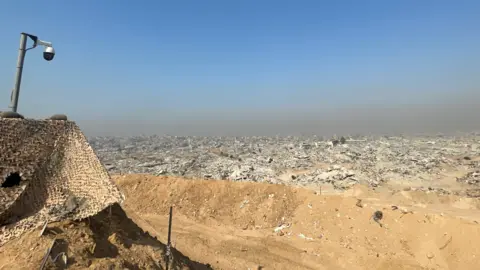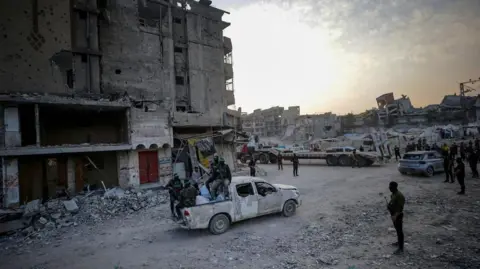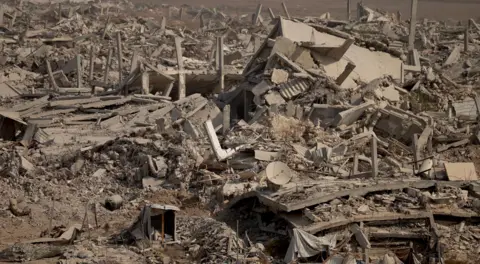Lucy WilliamsonMiddle East East, Gaza
From an embankment overlooking City City, there is no hiding what this war has done.
Gaza has disappeared from maps and memories, replaced by a monochrome landscape of garbage dumps and at 180 degrees, from Beit Hanoun on one side to Gaza City on the other.
Beyond the distant forms of buildings that still stand within City City, there is nothing left to orient you here, or identify neighborhoods that were once home to thousands of people.
It was one of the first areas that Israeli ground troops entered in the early weeks of the war. Since then they have returned several times, while Hamas has registered around its strongholds in the area.
Israel does not allow news organizations to report independently from Gaza. Today it took a group of journalists, including the BBC, to the area of the Strip occupied by Israeli forces.
The short visit is controlled and offered not available to Palestinians, or other areas of Gaza.
Israel’s military censorship laws mean that military personnel are shown our material before publication. The BBC retains editorial control of this report at all times.

Asked about the level of destruction in the area we visited, Israeli military spokesman Nadav Shoshani said it was “not a goal”.
“The purpose is to fight the terrorists. Almost every house has a tunnel shaft or is trapped or has an RPG [rocket-propelled grenade] or sniper station,” he said.
“If you drive fast, within a minute you can be inside an Israeli grandmother’s living room. That’s what happened on October 7.”
More than 1,100 people were killed in the attack by Hamas in Israel on 7 October 2023, and 251 others were injured.
Since then, more than 68,000 Gazans have been killed, according to the Hamas-run Health Ministry there.
The bodies of several hostages were found in this area, Lt Col SHOSHANIA said, including that of itsay chenreturned to Israel by Hamas this week. Searches continue for the missing bodies of the other seven hostages.
The Israeli military base we are traveling to is a hundred meters from the yellow line – the temporary border set by US President Donald Trump’s Peace Planwhich divides the areas of Gaza still controlled by Israeli forces from the areas controlled by Hamas.
The Israeli army has gradually marked the yellow line with blocks of land, as a warning to Hamas fighters and civilians.
There are no demarcations on this part of the line – a soldier pointed at me, emerging from a small patch of sand between the gray crumbs of ruined buildings.
 EPA
EPAThe ceasefire is almost a month old, but the Israeli forces said that they are still fighting with Hamas gunmoms in several lines “. The drums in the colors of Bronze Mark marking the firing points on the embankments facing Gaza City.
Hamas accused Israel of violating the cease-fire “hundreds of times”, and the Hamas-run Hamas-Run Ministry in Gaza said that more than 240 people had been killed.
Col SHOSHANI said that Israeli forces are committed to the US peace plan, but that they will also ensure that Hamas no longer threatens Israeli civilians, and will remain indispensable.
“It is very clear to everyone that Hamas is armed and wants to control Gaza,” he said. “It’s something that can be worked on, but we’re a long way from that.”
 Moose Campbell / BBC
Moose Campbell / BBCThe next stage of the US-led plan requires Hamas to disarm and hand over power to a Palestinian Committee of International Fumure including President Trump.
But instead of giving up power and weapons, Col SHOSHANI said, Hamas did the opposite.
“Hamas is trying to arm itself, trying to pretend it’s dominating, controlling Gaza,” he told me. “This is to kill people in broad daylight, to scare civilians and make sure they understand who is the boss of Gaza. We hope that this agreement will attack Hamas.”
The Israeli forces showed us a map of the tunnels
What happened in the next phase of this peace deal is unclear.
Arecteme left Gaza in a tense Limbo. Washington knew how fast the situation was – the truce had already fallen.
The US is pushing hard to move from a quick standoff to a more stable peace. It sent a draft resolution to the UN Security Council Members, seen by the BBC, which outlines a two-year mandate for an international stabilization and disarming Hamas in Gaza.
But details of this next stage of the deal are thin: it’s not clear which countries would send troops to secure Gaza ahead of Hamas disarmament, when Israel’s troops will withdraw, or how the members of Gaza’s new technocratic administration will be appointed.
President Trump has outlined his vision of Gaza as a futuristic Middle Eastern Hub, built with foreign investment. It’s a far cry from where Gaza is today.
Largely condemned by Israel, and seen as an investment by Trump, the question is not only who can stop the fighting, but what the gazans have to say about the future communities and lands.


